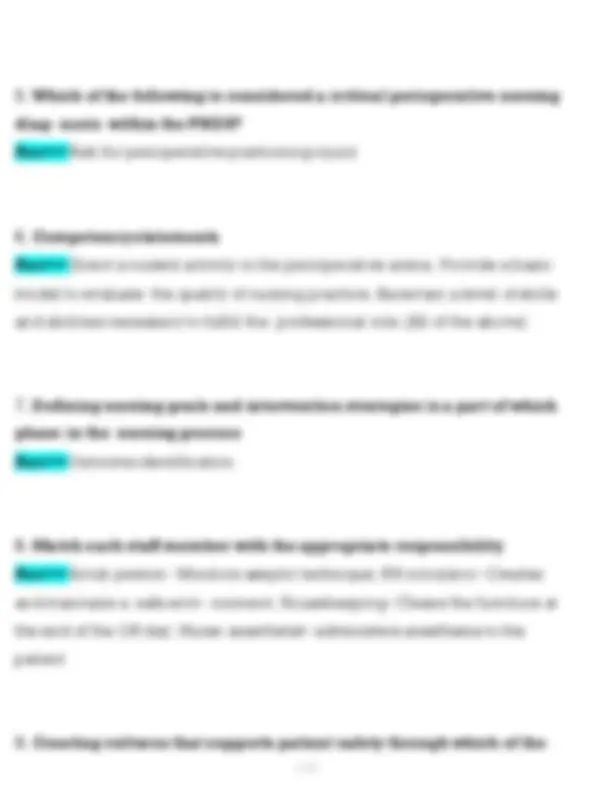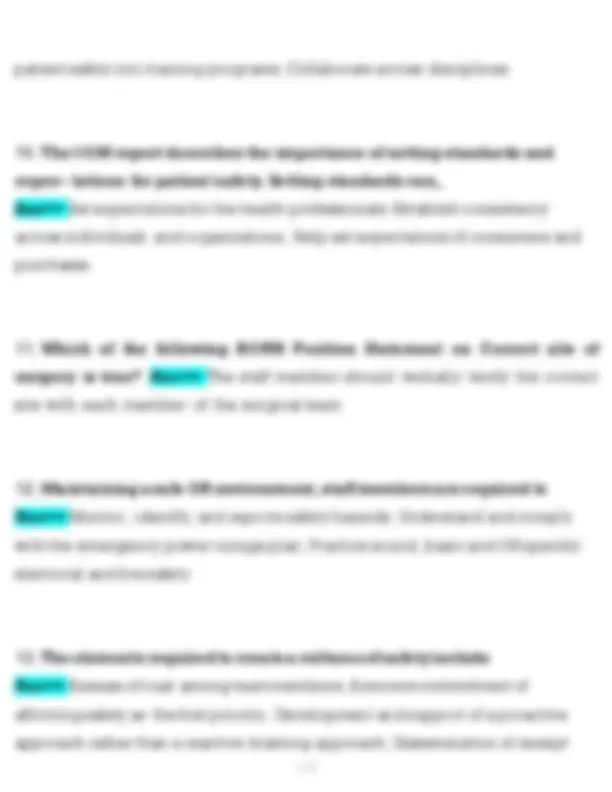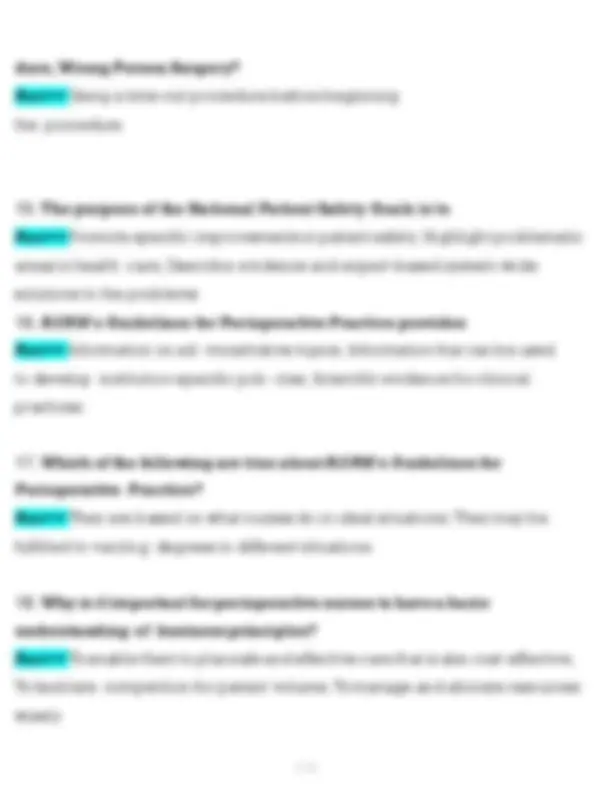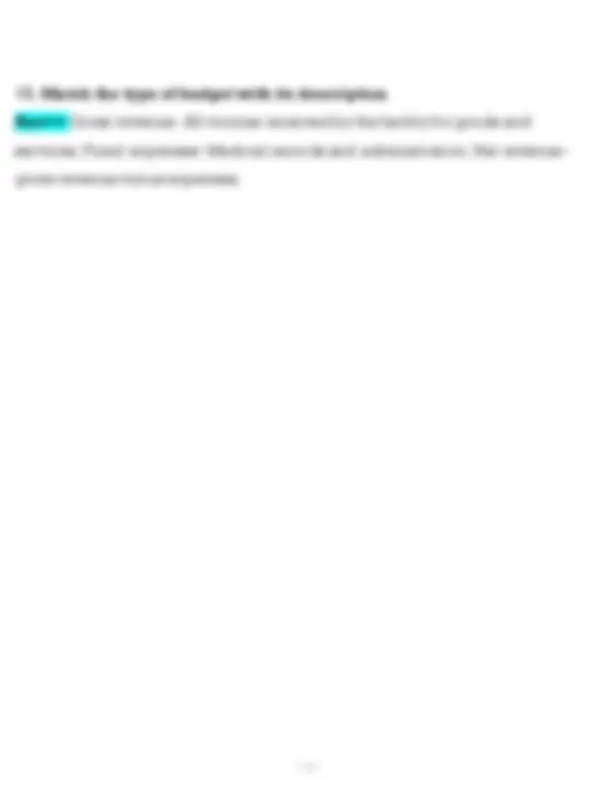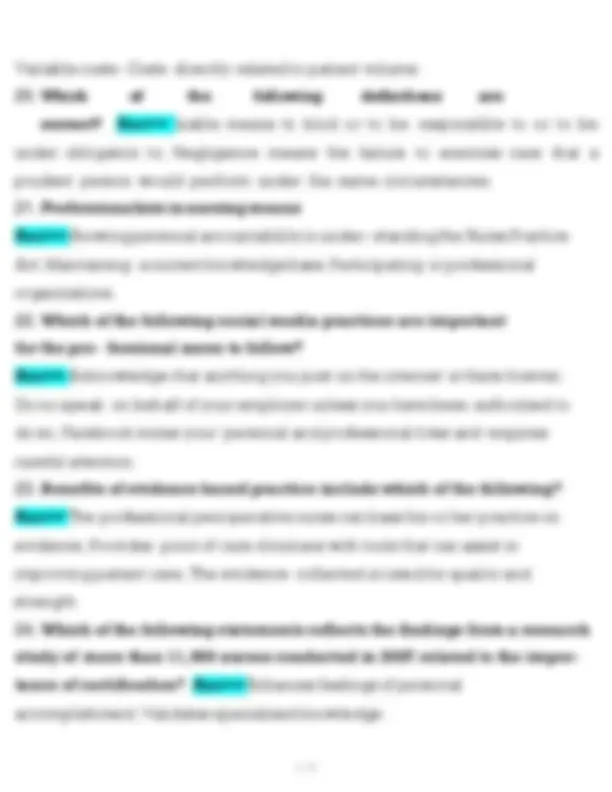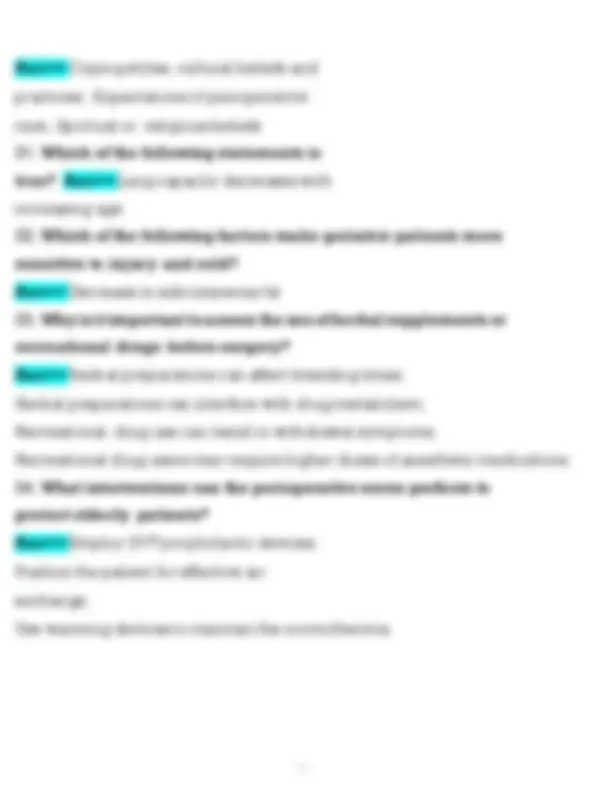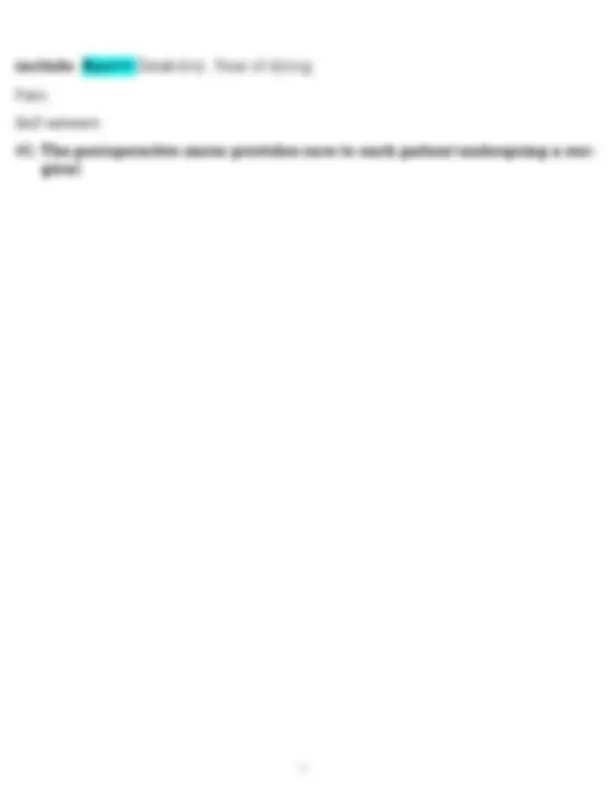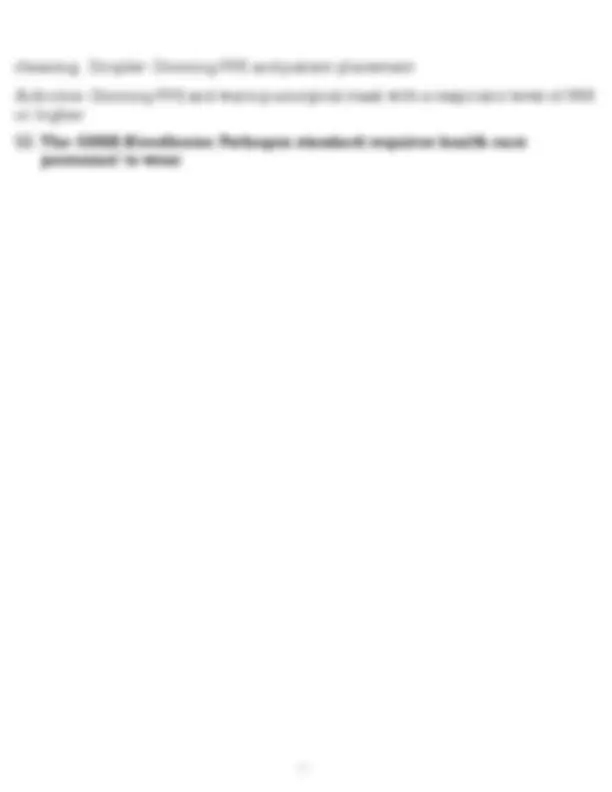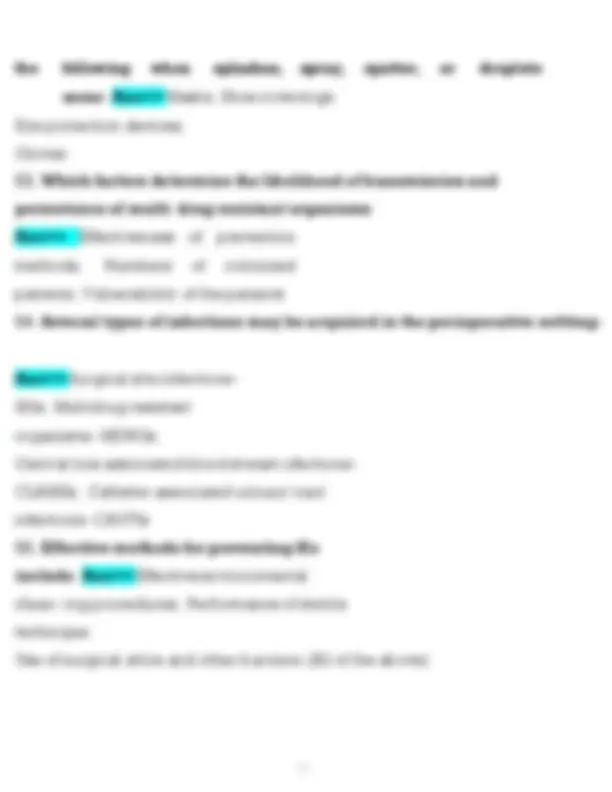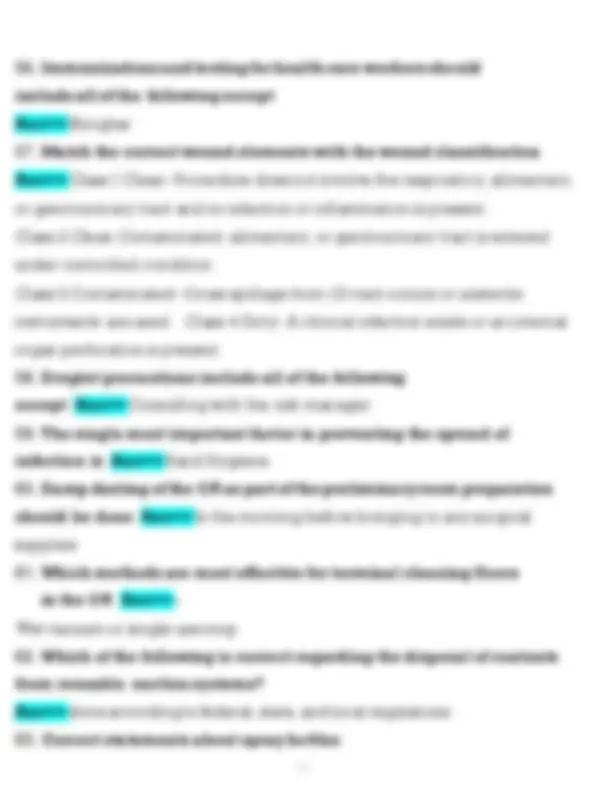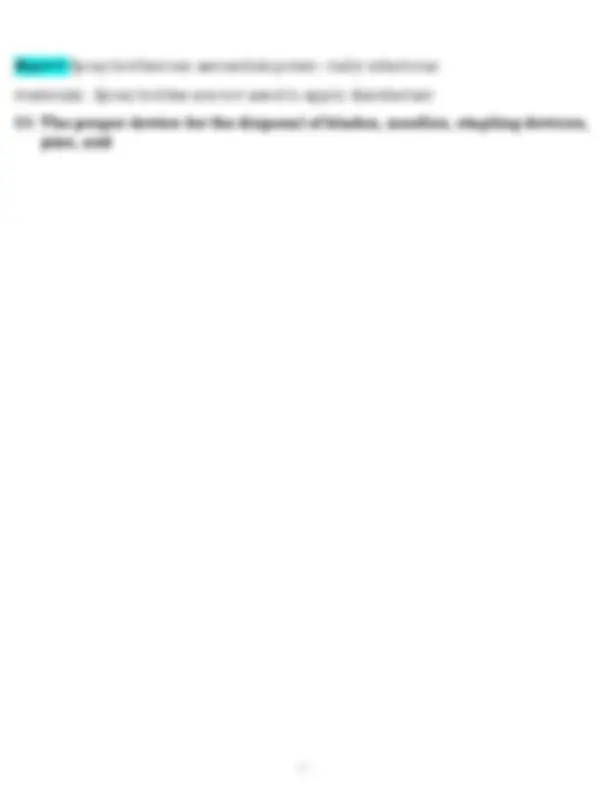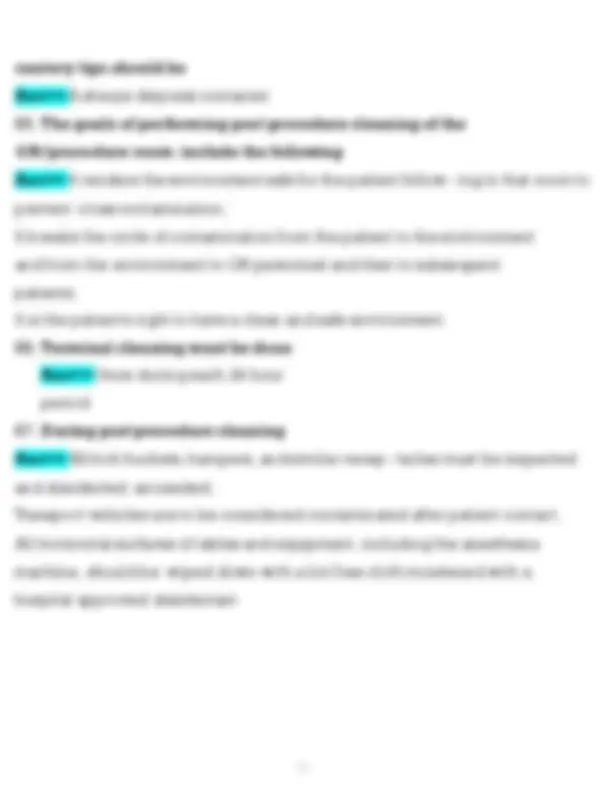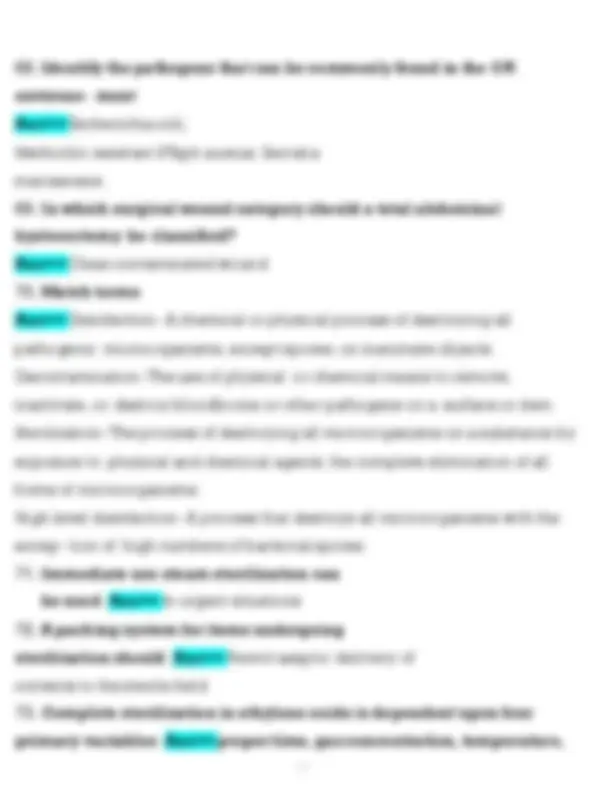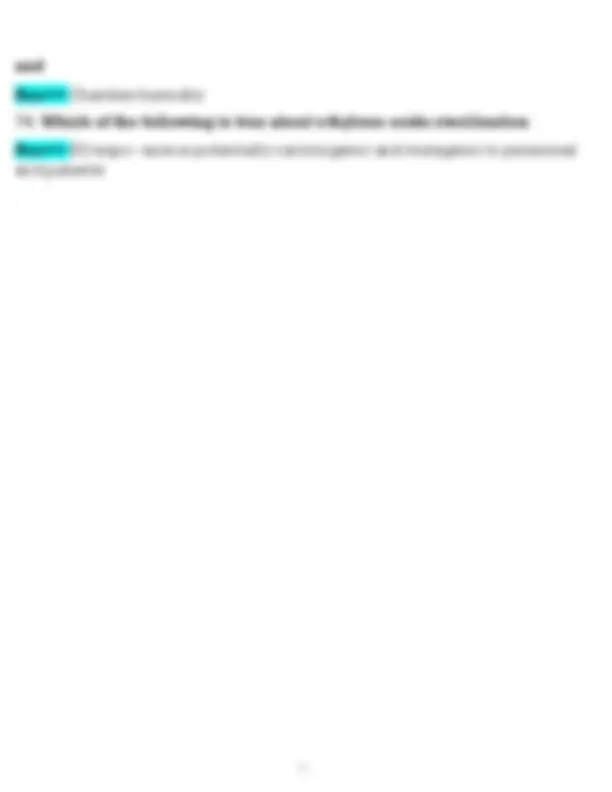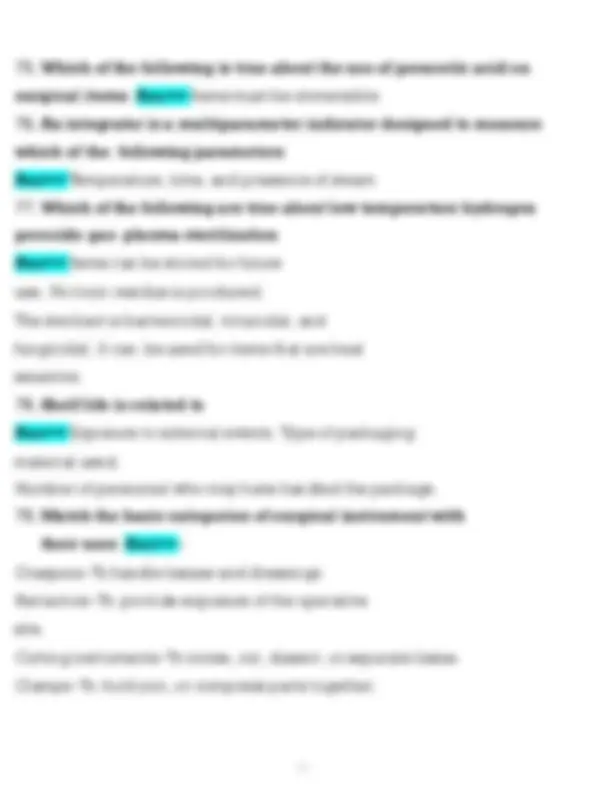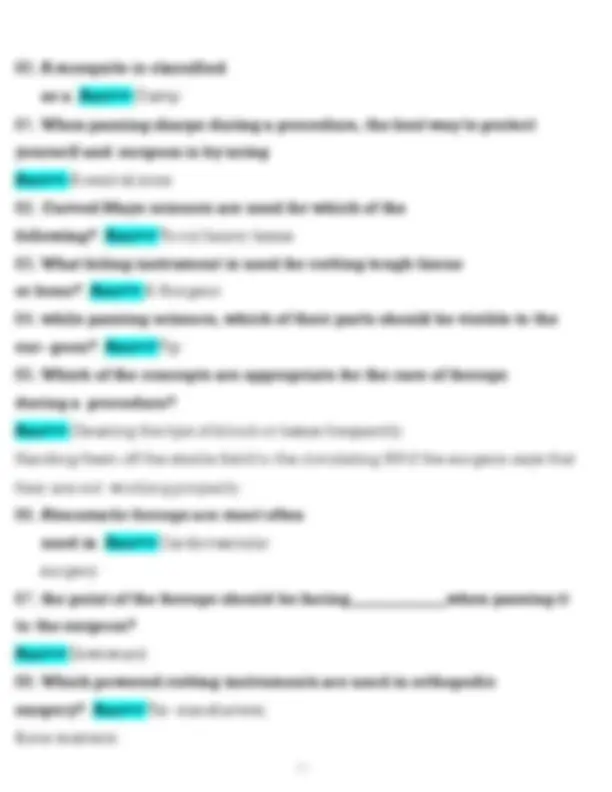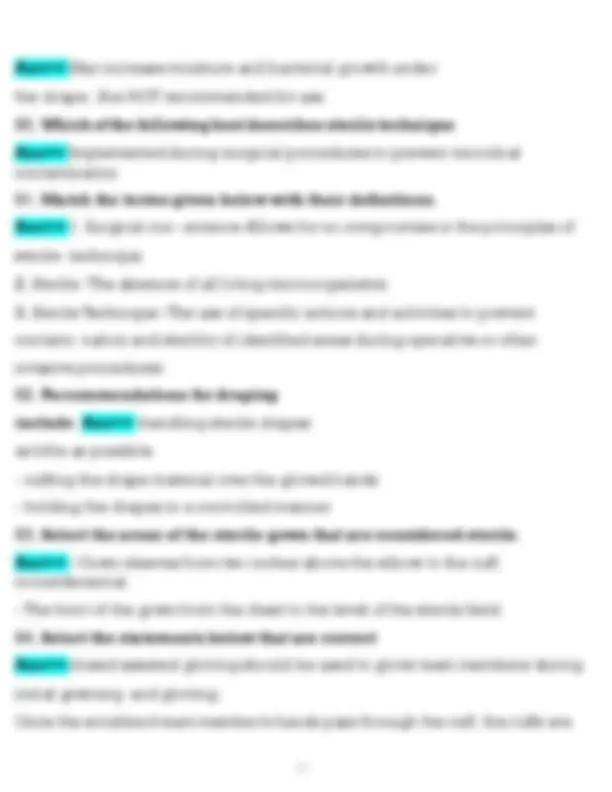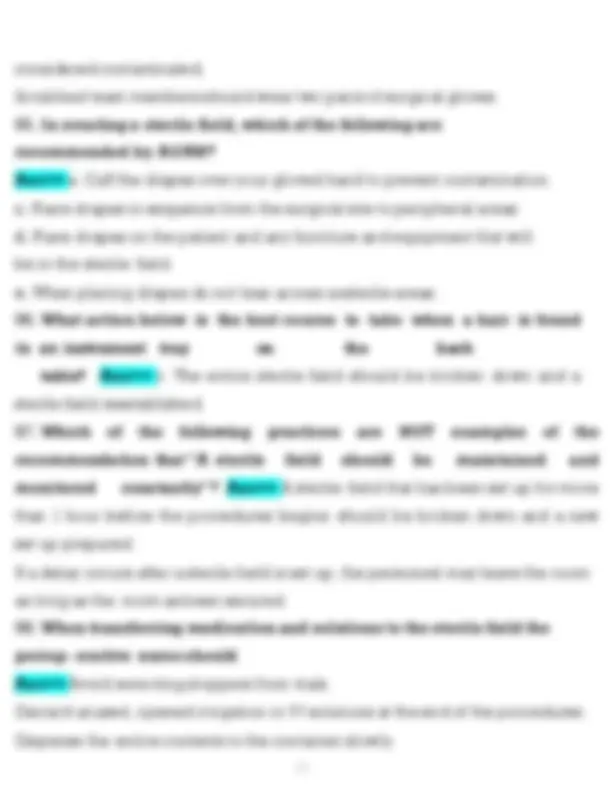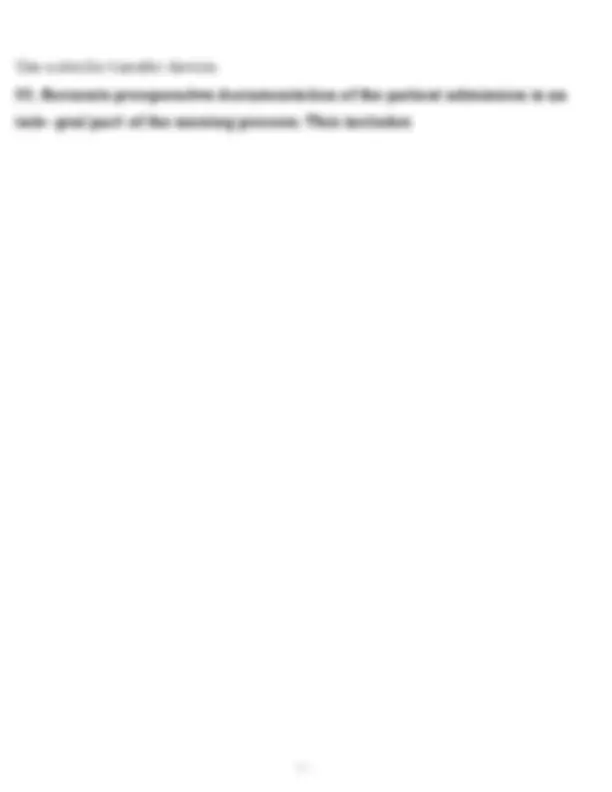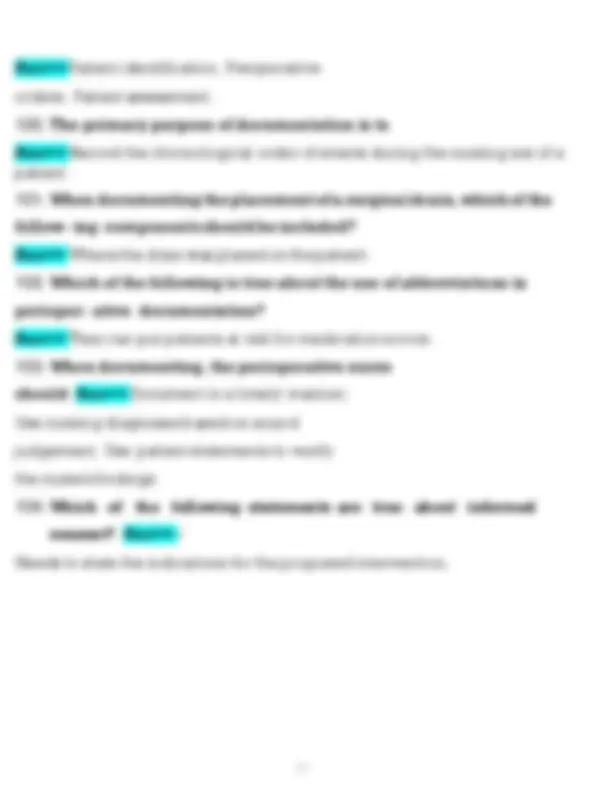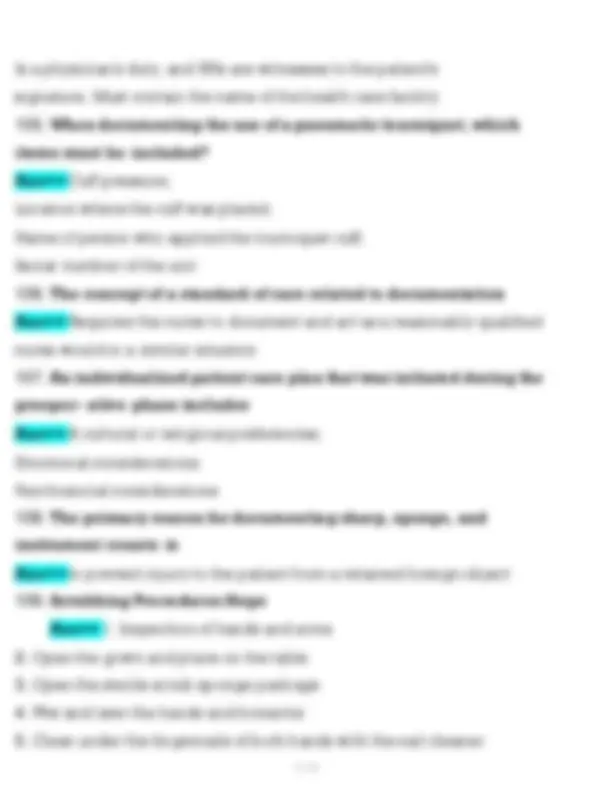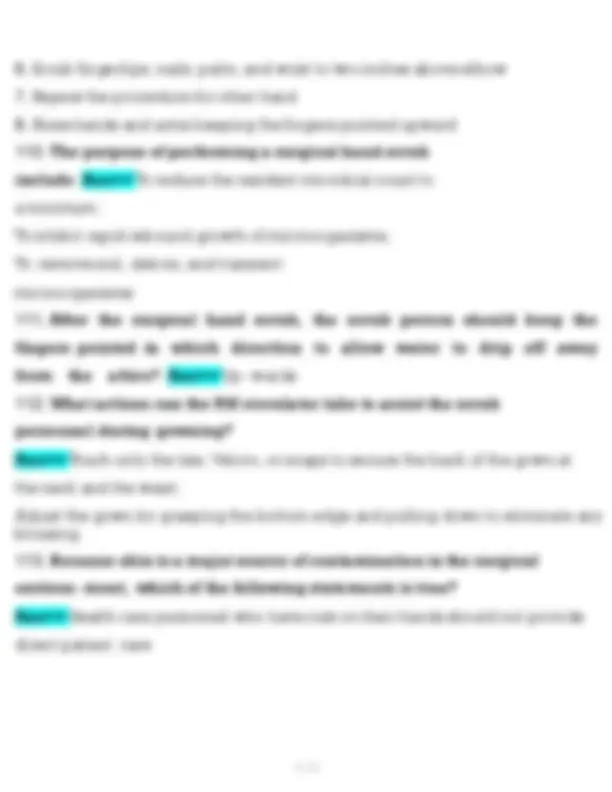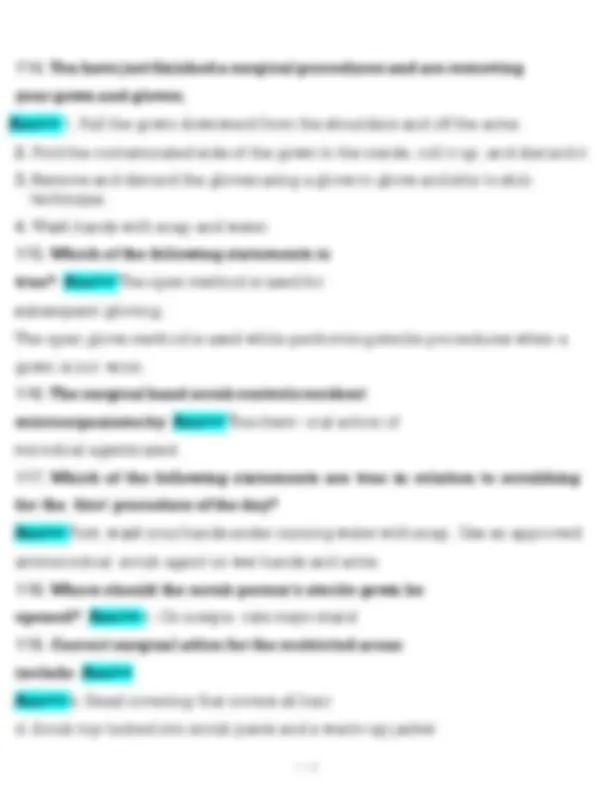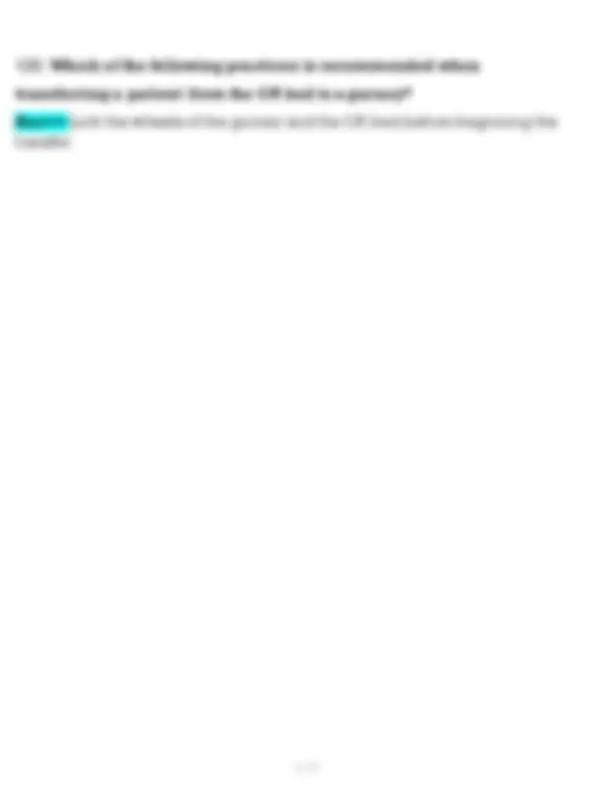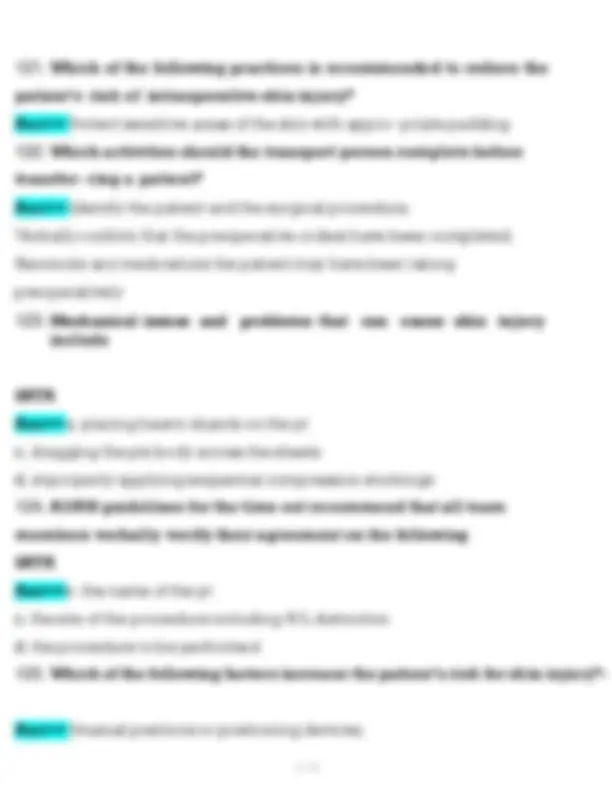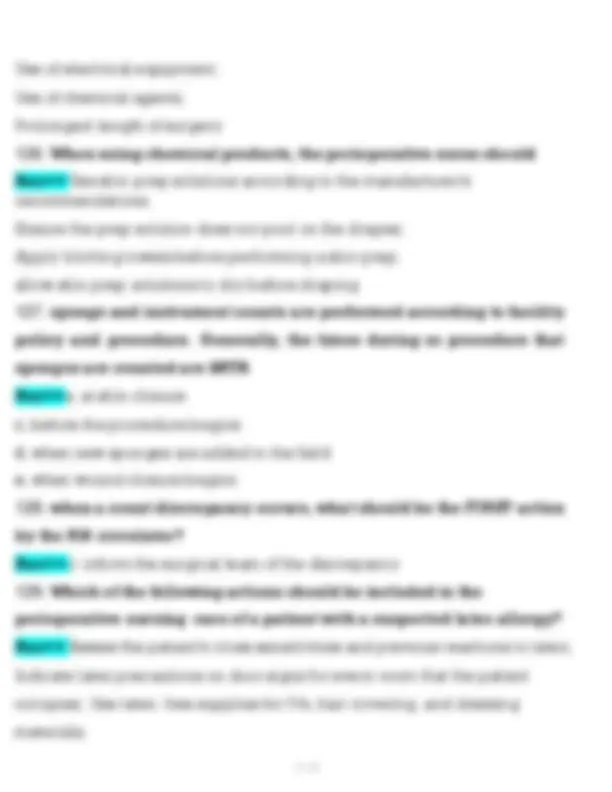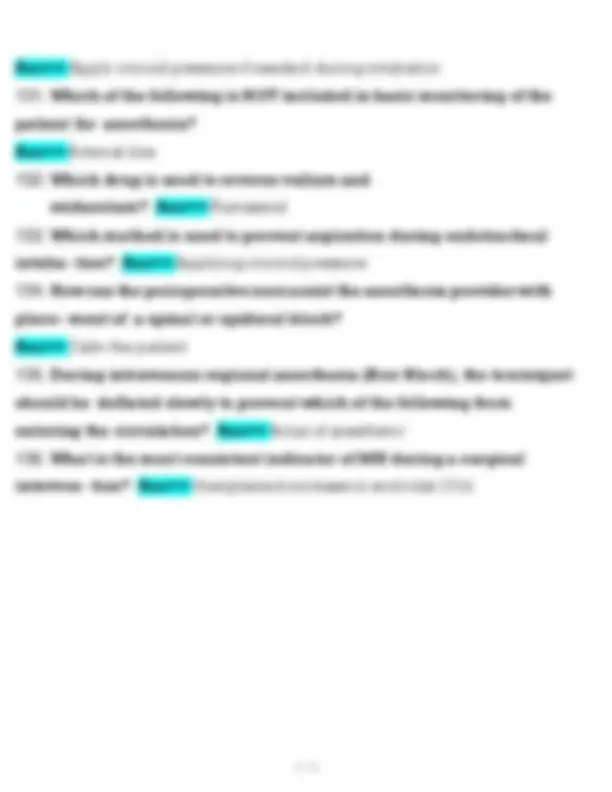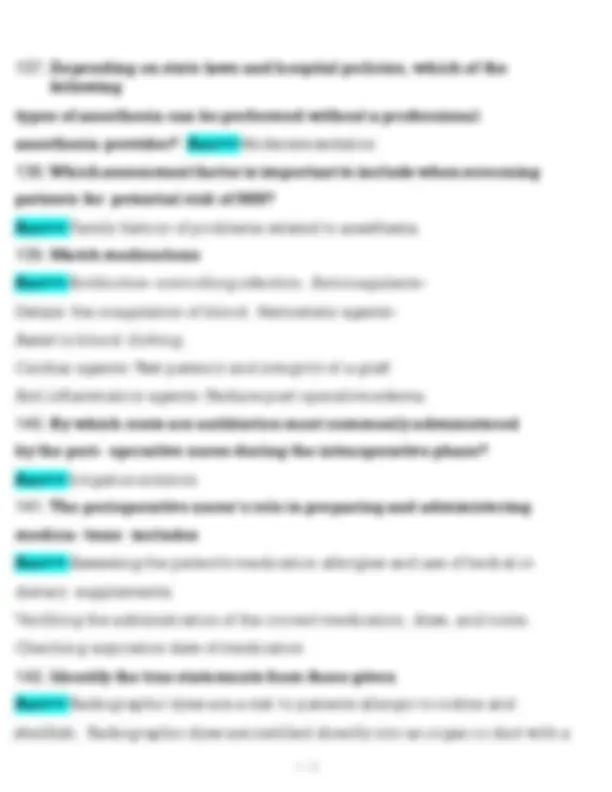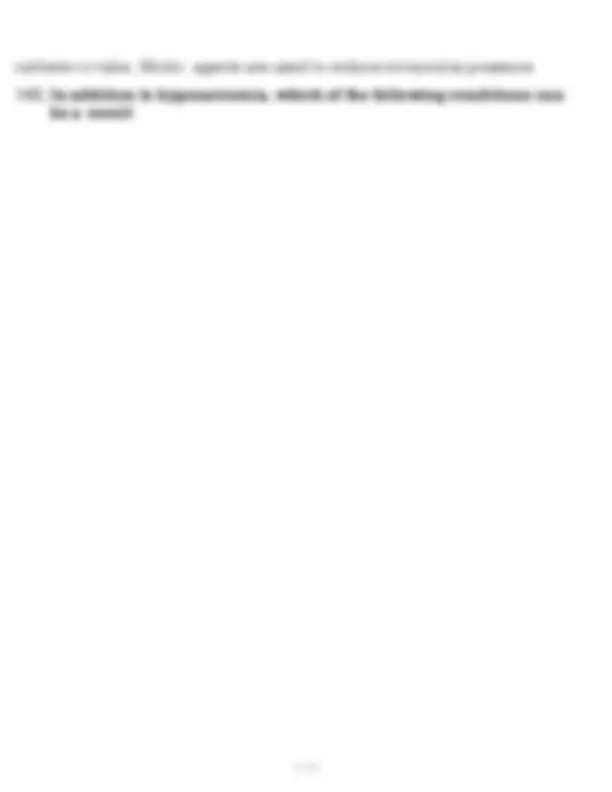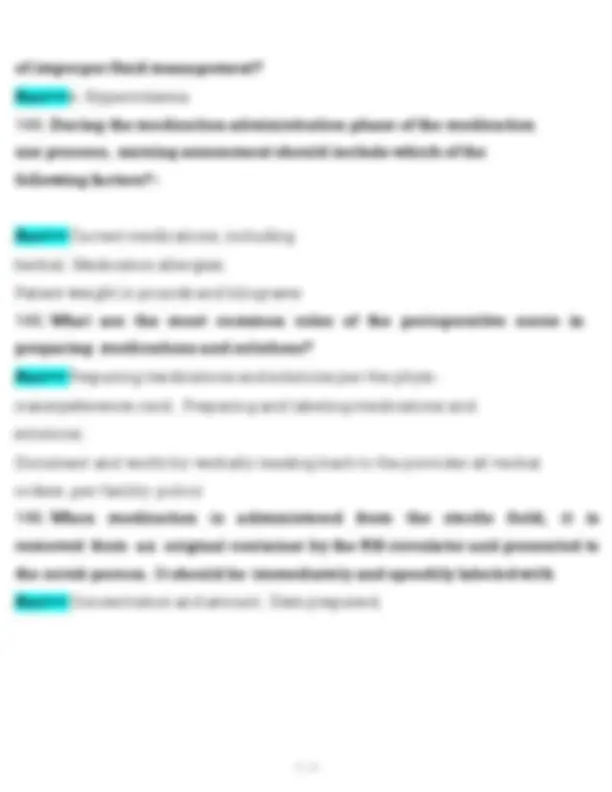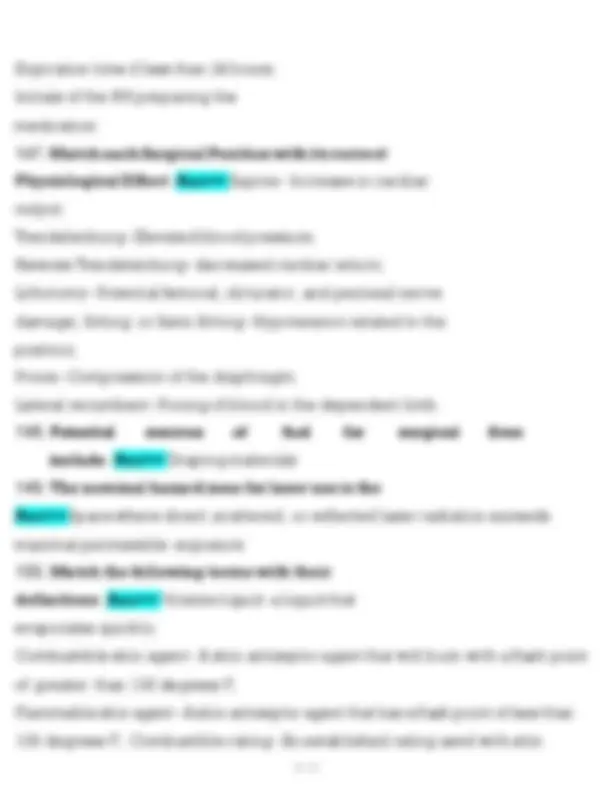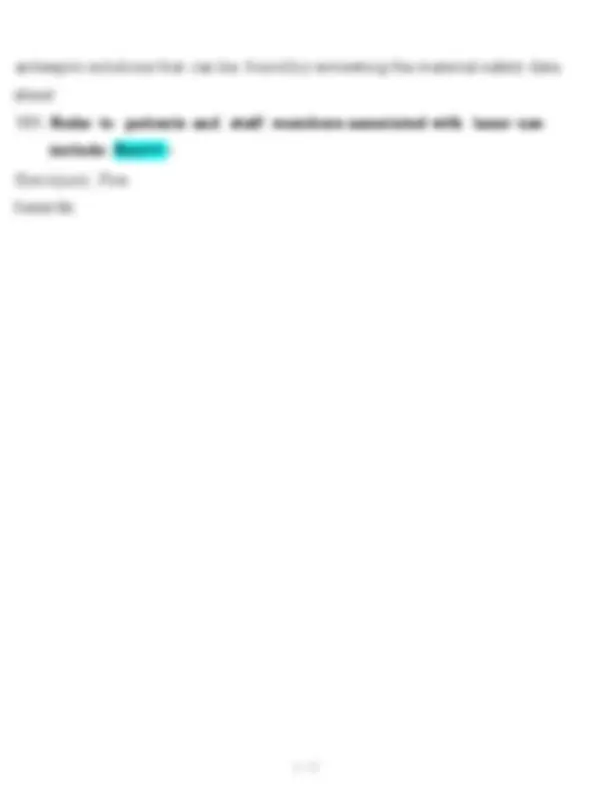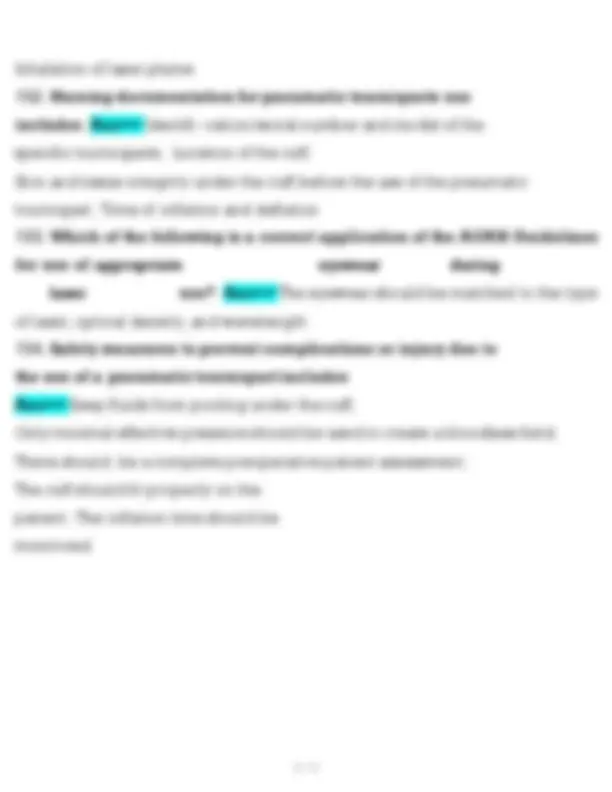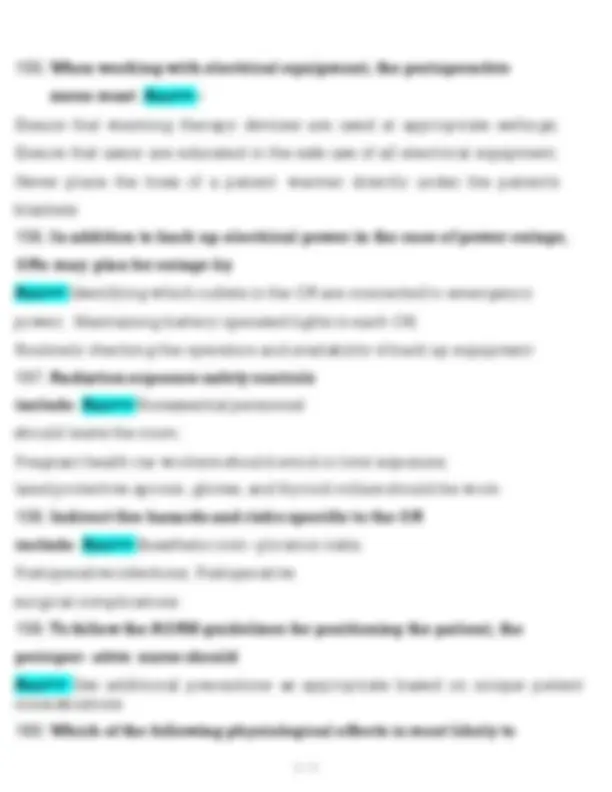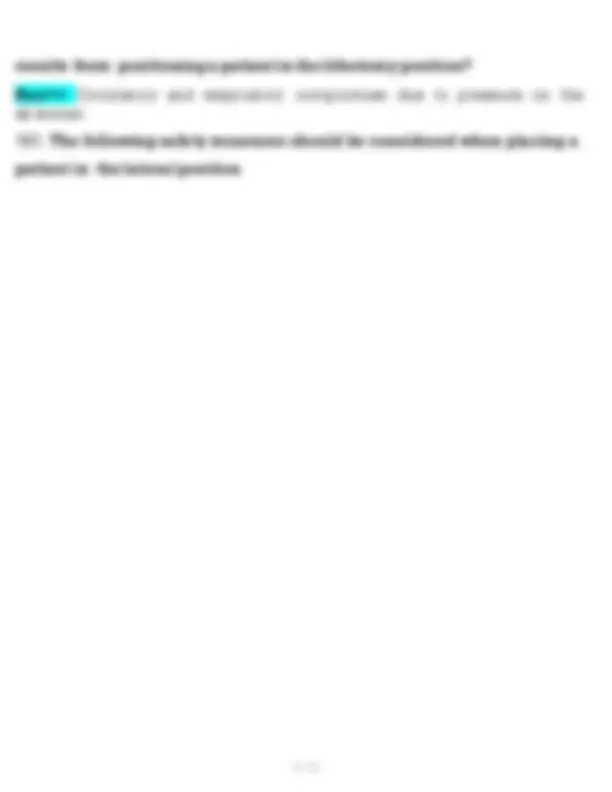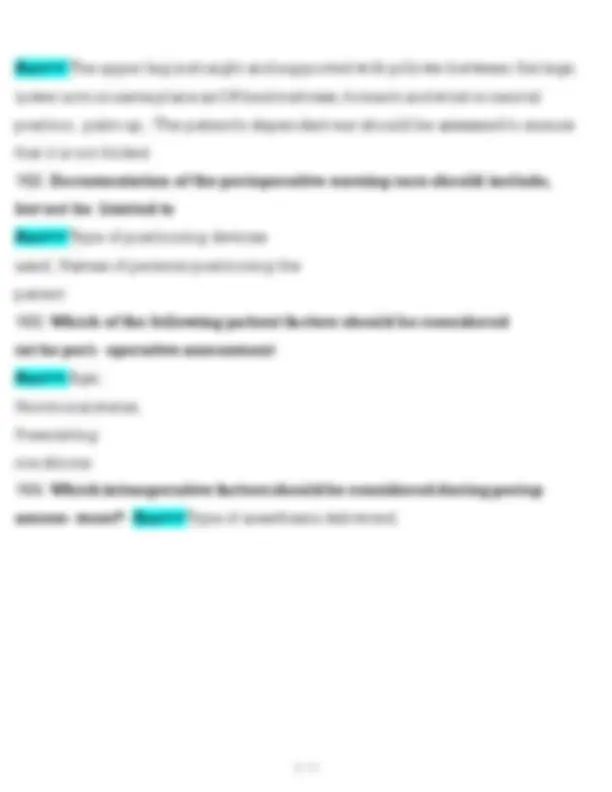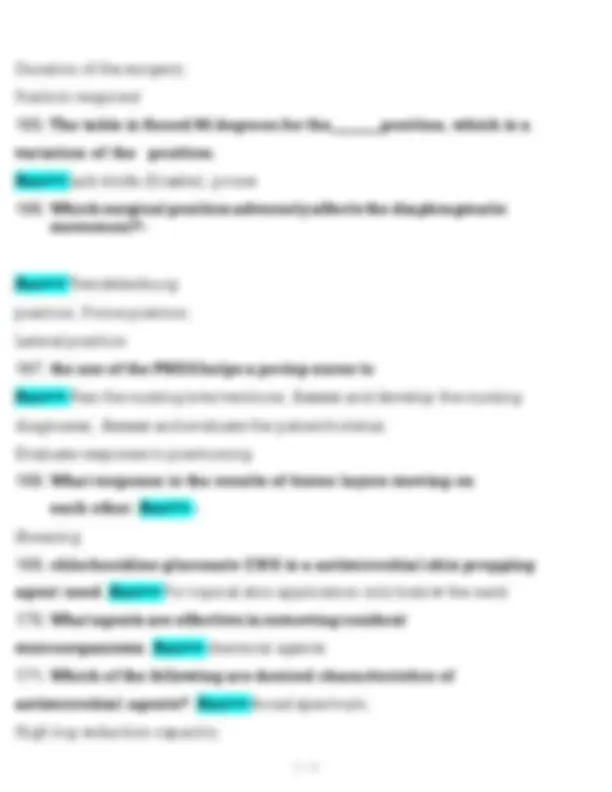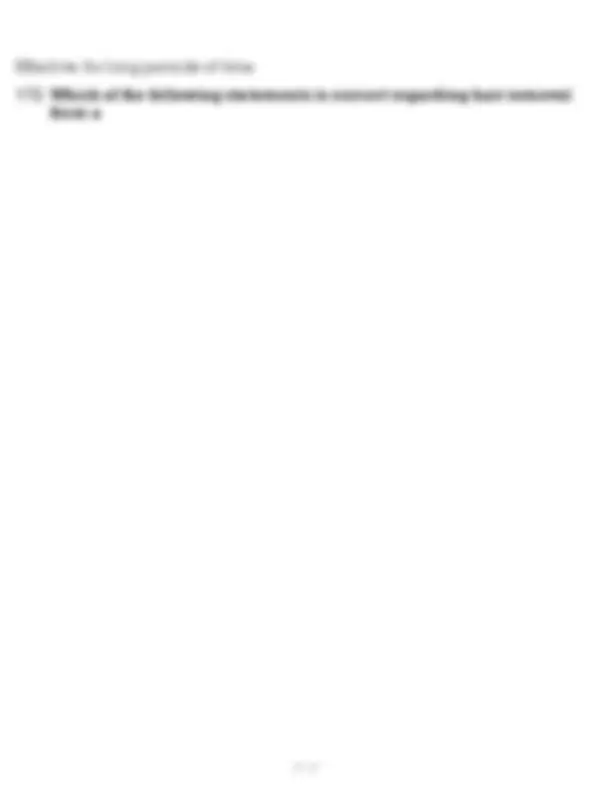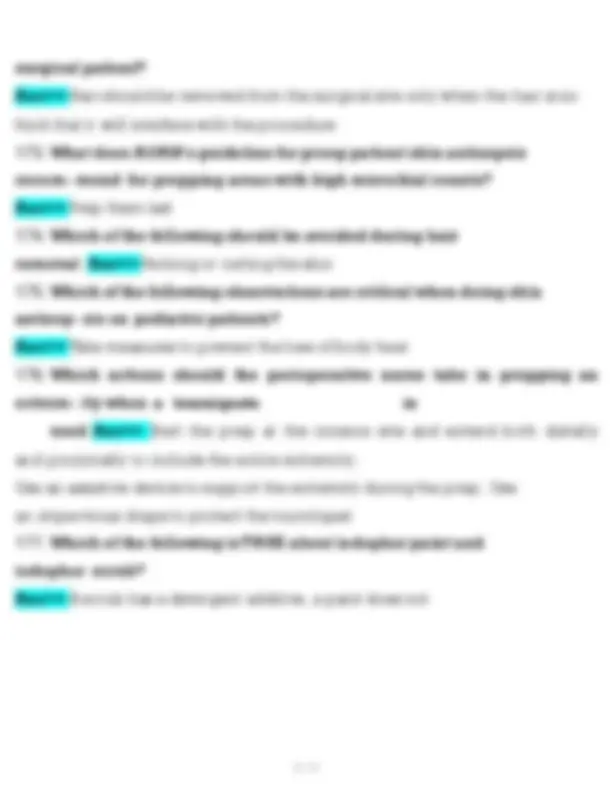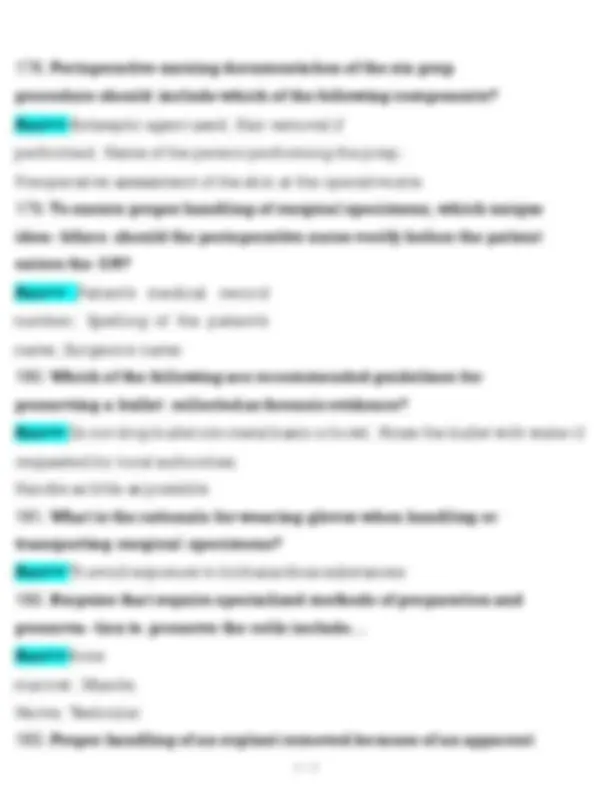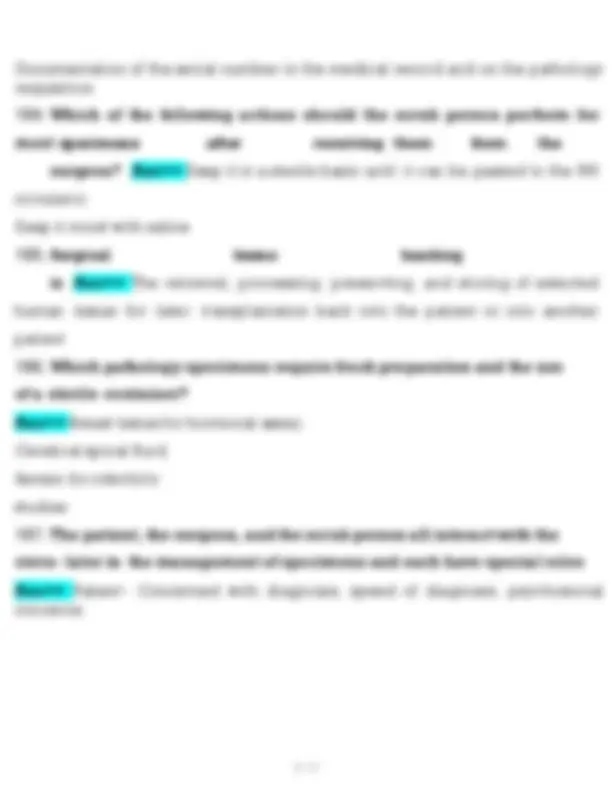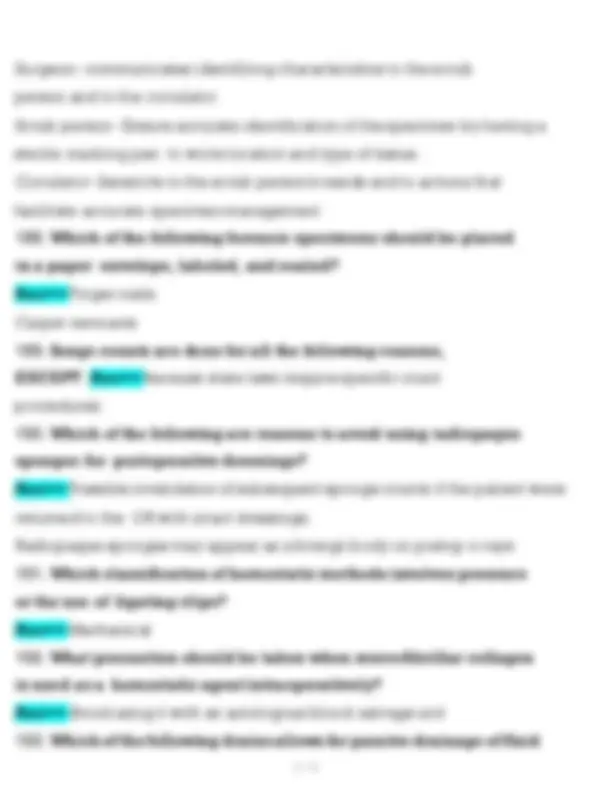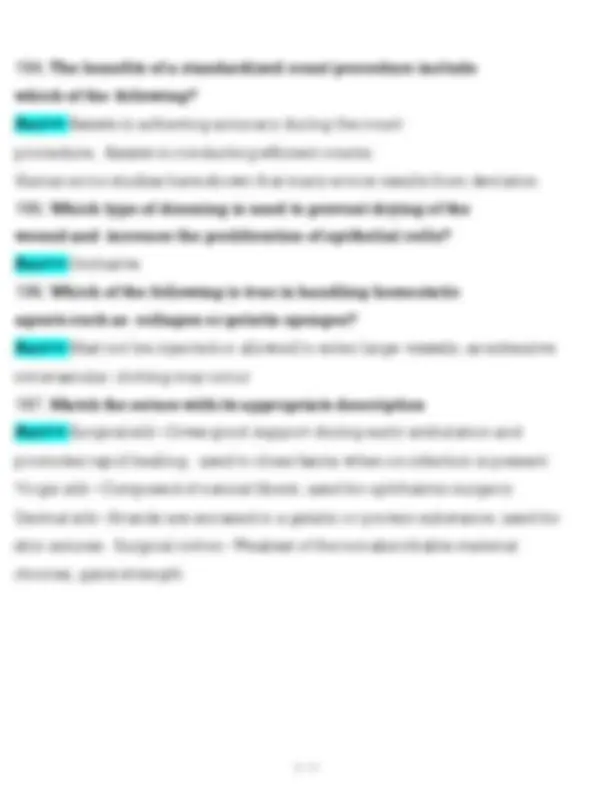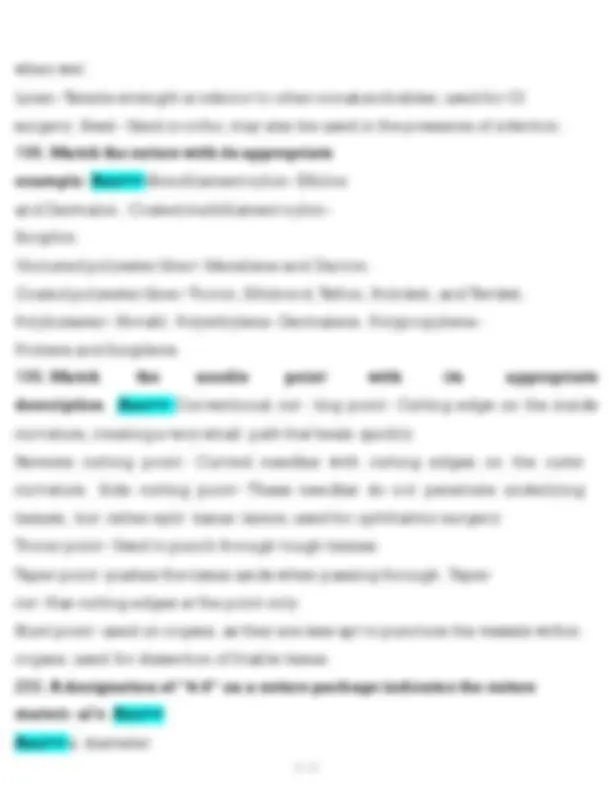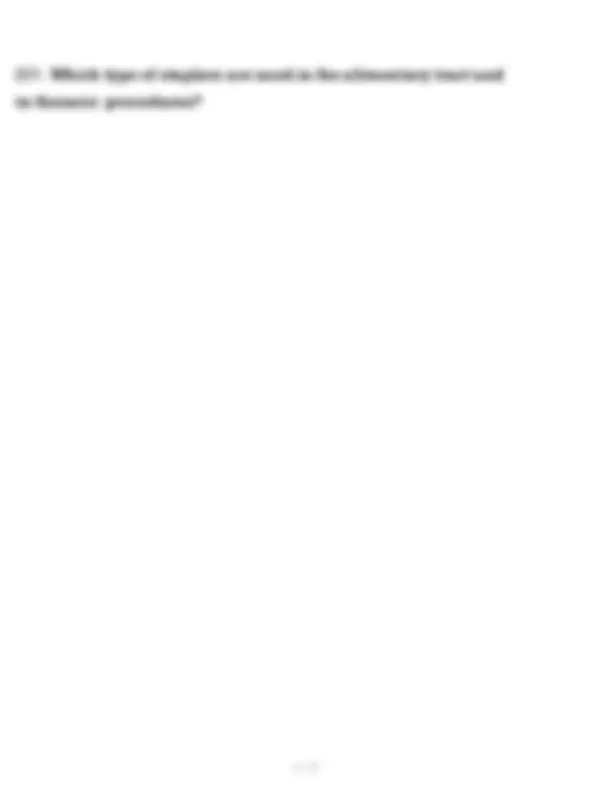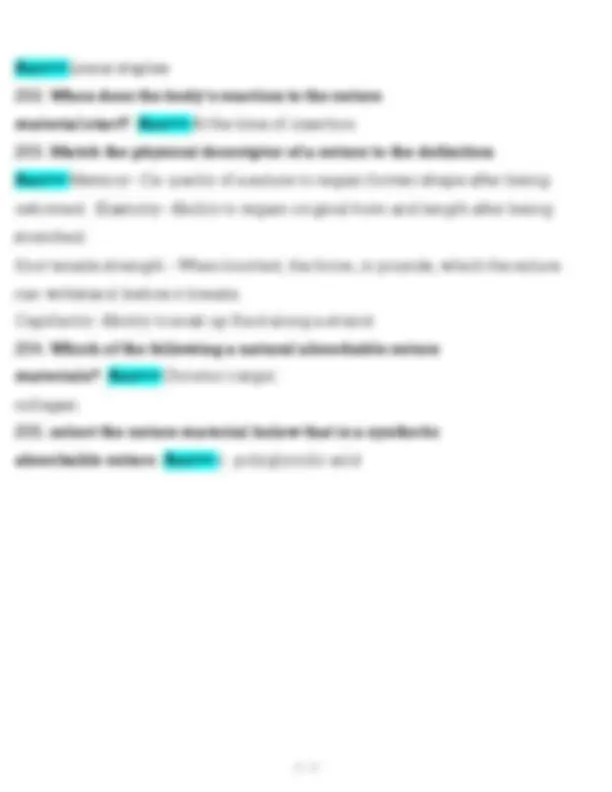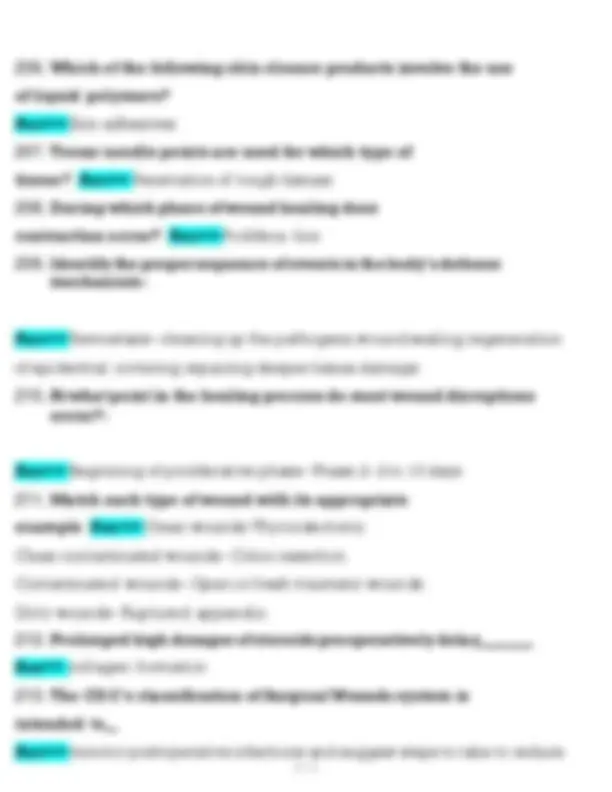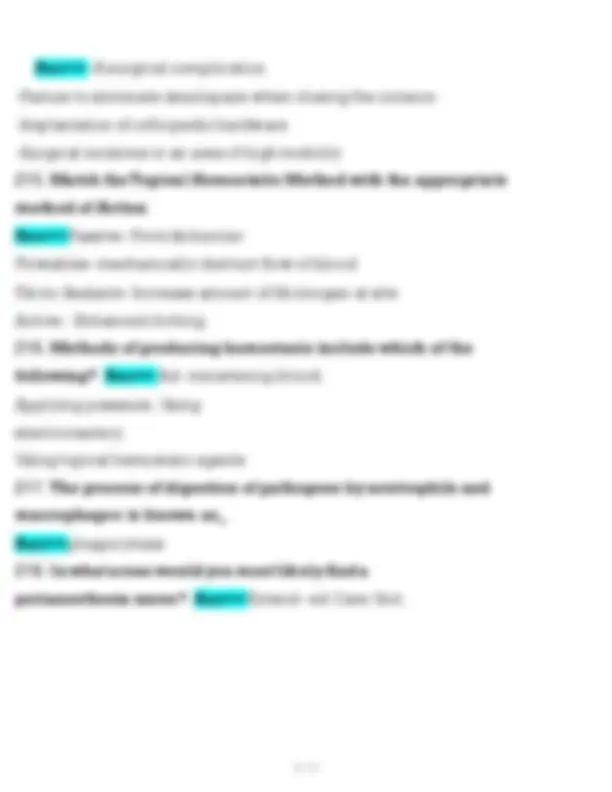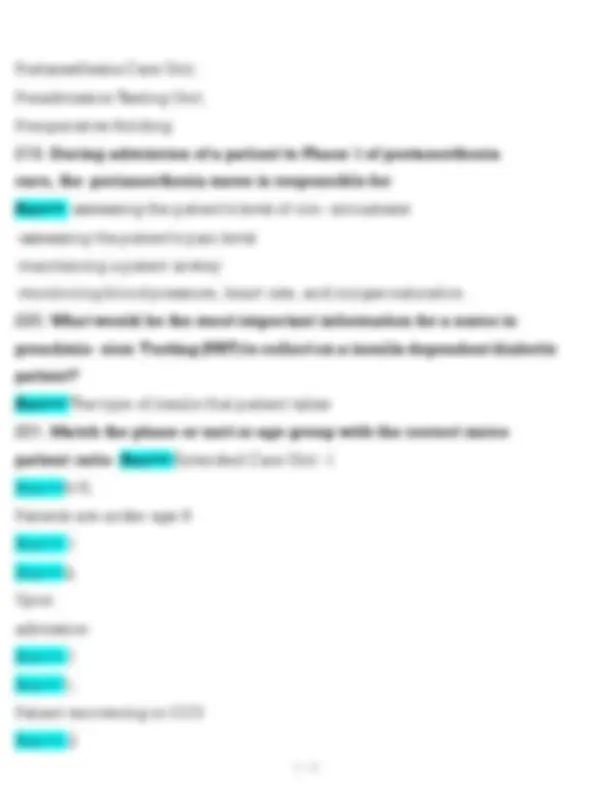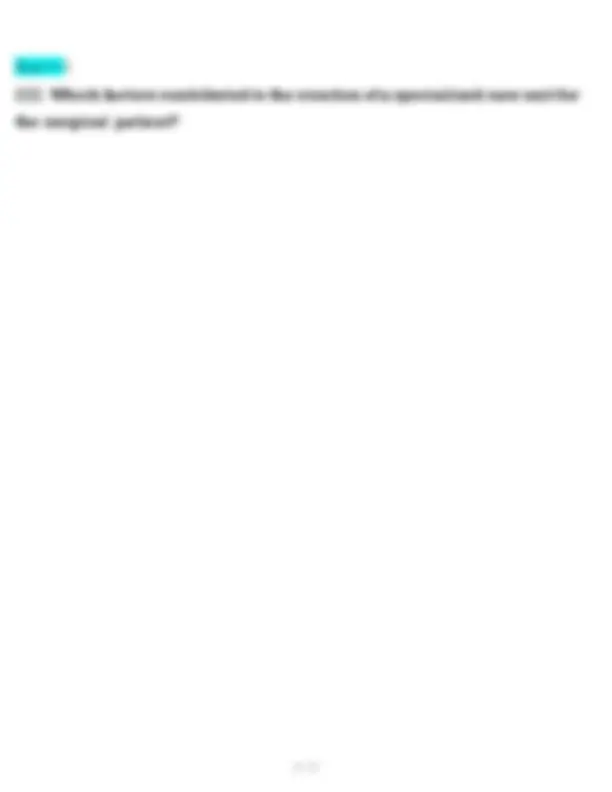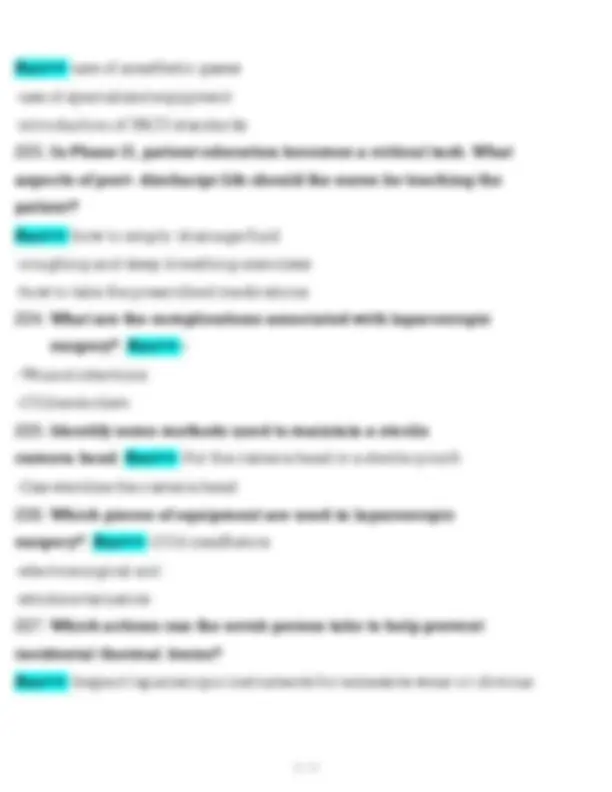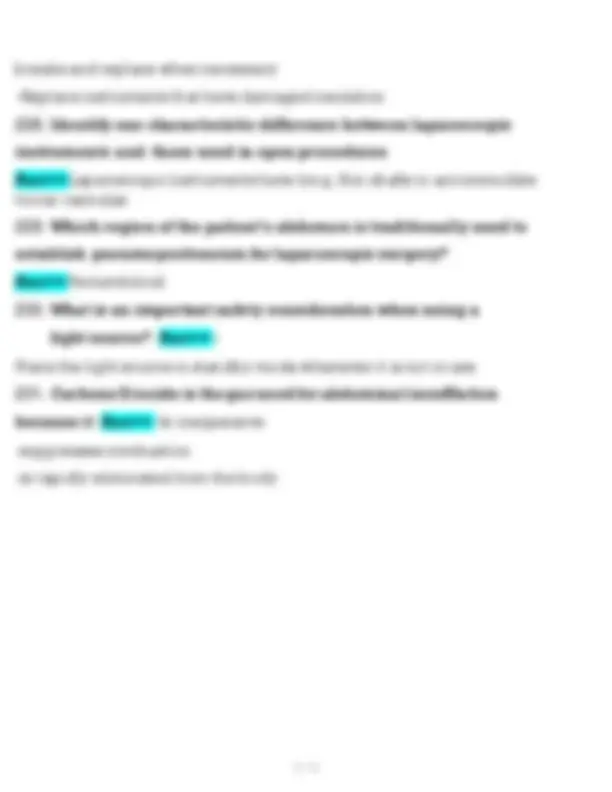Download AORN PERIOP 101 EXAM STUDY GUIDE 200+ Questions and Answers (Verified Revised Full Exam) and more Exams Nursing in PDF only on Docsity!
AORN PERIOP 101 EXAM STUDY GUIDE
200+ Questions and Answers (Verified Revised
Full Exam)
- In addition to the surgeon, which surgical team members wear sterile gowns and gloves during the procedure? Ans>> Scrub Person AND Surgical assistant
- The pathology laboratory and blood bank are usually situated in which of the following areas? Ans>> Unrestricted area
- What phases of the nursing process does the periopeartive nurse practice during the preoperative phase of the surgical experience? Ans>> Assessment, Iden- tification of desired outcome, Nursing diagnosis, Planning
- Data collection is part of which phase in the nursing
process Ans>> Assessment
fol- lowing mechanisms? Ans>> Convene and communicate with members about safety; Incorporate attention to
patient safety into training programs; Collaborate across disciplines.
- The IOM report describes the importance of setting standards and expec- tations for patient safety. Setting standards can Ans>> Set expectations for the health professionals; Establish consistency across individuals and organizations; Help set expectations of consumers and purchases.
- Which of the following AORN Position Statement on Correct site of surgery is true? Ans>> The staff member should verbally verify the correct site with each member of the surgical team
- Maintaining a safe OR environment, staff members are required to Ans>> Monitor, identify, and reports safety hazards; Understand and comply with the emergency power outage plan; Practice sound, basic and OR specific electrical and fire safety.
- The elements required to create a cultures of safety include Ans>> A sense of trust among team members; A sincere commitment of affirming safety as the first priority; Development and support of a proactive approach rather than a reactive blaming approach; Dissemination of receipt
Commission's Universal Protocol for preventing Wrong Site, Wrong Proce-
dure, Wrong Person Surgery? Ans>> Using a time-out procedure before beginning the procedure
- The purpose of the National Patient Safety Goals is to Ans>> Promote specific improvements in patient safety; Highlight problematic areas in health care; Describe evidence and expert-based system-wide solutions to the problems
- AORN's Guidelines for Perioperative Practice provides Ans>> Information on ad- ministrative topics; Information that can be used to develop institution-specific poli- cies; Scientific evidence for clinical practices.
- Which of the following are true about AORN's Guidelines for Perioperative Practice? Ans>> They are based on what nurses do in ideal situations; They may be fulfilled to varying degrees in different situations.
- Why is it important for perioperative nurses to have a basic understanding of business principles? Ans>> To enable them to plan safe and effective care that is also cost-effective; To facilitate competition for patient volume; To manage and allocate resources wisely
Variable costs- Costs directly related to patient volume
- Which of the following definitions are correct? Ans>> Liable means to bind or to be responsible to or to be under obligation to; Negligence means the failure to exercise care that a prudent person would perform under the same circumstances.
- Professionalism in nursing means Ans>> Showing personal accountability in under- standing the Nurse Practice Act; Maintaining a current knowledge base; Participating in professional organizations.
- Which of the following social media practices are important for the pro- fessional nurse to follow? Ans>> Acknowledge that anything you post on the internet is there forever; Do no speak on behalf of your employer unless you have been authorized to do so; Facebook mixes your personal and professional lives and requires careful attention.
- Benefits of evidence based practice include which of the following? Ans>> The professional perioperative nurse can base his or her practice on evidence; Provides point of care clinicians with tools that can assist in improving patient care, The evidence collected is rated for quality and strength.
- Which of the following statements reflects the findings from a research study of more than 11,000 nurses conducted in 2007 related to the impor- tance of certification? Ans>> Enhances feelings of personal accomplishment; Validates specialized knowledge.
- For a professional nurse, personal accountability means
Ans>> Willingness to take responsibility for one's actions; Being dependable in all situations; Making the best decisions with the input available; Willingness to bare consequences for one's actions
- Which of the following statements are true about objective data? Ans>> Data that is the information written in the patient's record and nursing notes; History, physical, and laboratory data are examples of objective data
- Match the age groups with their ability for learning and understanding Ans>> - Birth to one month- The child is able to express only through crying; 1-12 months- The baby will smile, babble, and gurgle; One to three years- The baby is able to understand and respond to simple com- mands; Three to six years- The child is able to literally interpret terms.
- Patients in which of the following age groups have the greatest blood volume per unit of body weight? Ans>> Children
- During the preoperative interview, why should the perioperative nurse ask patients about their use of herbal preparations, alcohol, tobacco, and recreational drugs? Ans>> Herbal supplements may affect the metabolism of drugs
Ans>> Coping styles; cultural beliefs and practices; Expectations of perioperative care; Spiritual or religious beliefs
- Which of the following statements is true? Ans>> Lung capacity decreases with increasing age
- Which of the following factors make geriatric patients more sensitive to injury and cold? Ans>> Decrease in subcutaneous fat
- Why is it important to assess the use of herbal supplements or recreational drugs before surgery? Ans>> Herbal preparations can affect bleeding times; Herbal preparations can interfere with drug metabolism; Recreational drug use can result in withdrawal symptoms; Recreational drug users may require higher doses of anesthetic medications.
- What interventions can the perioperative nurse perform to protect elderly patients? Ans>> Employ DVT prophylactic devices; Position the patient for effective air exchange; Use warming devices to maintain the normothermia
- A child in which of the following age groups can be described as "likes to socialized and can interpret terms"? Ans>> 3 to 6 years
- The goal of patient and family education is to Ans>> Provide information to the patient; Improve knowledge; Achieve long lasting changes in behavior; Take ownership of the patient's care; Improve the patient's outcome.
- The importance of patient and family education is reflected by which of the following phrases? Ans>> Improvement in quality of care; Increase in patient satisfaction; Increase in patient compliance; Ethical and legal mandates for patient education
- Which of the following form part of patient's ongoing education needs as a patient? Ans>> Contact information for questions or concerns after surgery; Counseling on modified diet to be followed after surgery; List of foods that might interfere with prescribed mediation; Medications to be given and time intervals for taking.
- Factors that affect the patient's ability to learn
intervention in a manner that preserves and protects Ans>> Patient autonomy, dignity, and human rights
- Patient and family education is a combination process involving Ans>> Influenc- ing behavior; Producing changes in knowledge; Producing change in attitudes and skills
- Factors that may affect an adult patient's ability to learn include Ans>> Age; Attitude; Emotional state; Intellectual ability; Physical ability
- The perioperative nurse should use the directive interview technique over a nondirective interview technique when the information he or she needs Ans>> - Consists of predetermined questions; Consists of questions in a predetermined order; Is to document the patient's health history
- A preoperative patient's DNR order is Ans>> Reconsidered to ensure that the risks and benefits of anesthesia and surgery are discussed before surgery
- Obtaining informed consent is a two step process of Ans>> Communicating infor- mation and documenting the decision
- How does the perioperative nurse test the patient's level of understand- ing? Ans>> By asking questions about the procedure and evaluating the answer
- A directive interview is Ans>> Structures with predetermined questions
- Factors that may affect the amount of pain the patient will experience postoperatively are Ans>> The surgical site; The nature and intended purpose of the surgery; the patient's fears regarding anesthesia or surgery
- Which of the three elements required for an infection to occur is related to inanimate environmental surfaces? Ans>> Source or Reservoir
- One of the most effective ways to prevent disease transmission and con- trol infections in health care settings is Ans>> Hand Hygiene
- Match the three types of transmission based precautions with the correct examples of precautions that should be implemented Ans>> Contact- Donning PPE and environmental
the following when splashes, spray, spatter, or droplets occur Ans>> Masks; Shoe coverings; Eye protection devices; Gloves
- Which factors determine the likelihood of transmission and persistence of multi drug resistant organisms Ans>> Effectiveness of prevention methods; Numbers of colonized patients; Vulnerability of the patients
- Several types of infections may be acquired in the perioperative settting-
Ans>> Surgical site infections- SSIs; Multidrug resistant organisms- MDROs; Central line associated blood stream nfections- CLABSIs; Catheter associated urinary tract infections- CAUTIs
- Effective methods for preventing SIs include Ans>> Effective environmental clean- ing procedures; Performance of sterile technique; Use of surgical attire and other barriers (All of the above)
- Immunizations and testing for health care workers should include all of the following except Ans>> Shingles
- Match the correct wound elements with the wound classification Ans>> Class I Clean- Procedure does not involve the respiratory, alimentary, or genitourinary tract and no infection or inflammation is present. Class 2 Clean Contaminated- alimentary, or genitourinary tract is entered under controlled condition. Class 3 Contaminated- Gross spillage from GI tract occurs or unsterile instruments are used. Class 4 Dirty- A clinical infection exists or an internal organ perforation is present.
- Droplet precautions include all of the following except Ans>> Consulting with the risk manager
- The single most important factor in preventing the spread of infection is Ans>> Hand Hygiene
- Damp dusting of the OR as part of the preliminary room preparation should be done Ans>> In the morning before bringing in any surgical supplies
- Which methods are most effective for terminal cleaning floors in the OR Ans>> - Wet vacuum or single use mop
- Which of the following is correct regarding the disposal of contents from reusable suction systems? Ans>> done according to federal, state, and local regulations
- Correct statements about spray bottles

